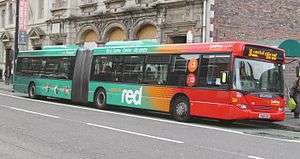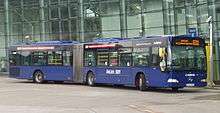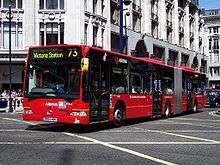Articulated buses in the United Kingdom
%2C_7_April_2007.jpg)
Articulated buses were rarely used in the United Kingdom compared to other countries, until the turn of the millennium. This was historically due to the UK preference for the double-decker bus for use on high capacity routes. As of June 2006, there were over 500 articulated buses in the UK,[1] although they are still heavily outnumbered by double deckers. The majority of this fleet was used in London, although in August 2008 it was announced these buses would be withdrawn by end of 2011.[2]
History
Until 1980 articulated buses were illegal for British roads due to their length. Following an exemption, the first trials in the UK used vehicles by MAN and Leyland-DAB.
MAN Bendibus, 1979
The first to carry passengers on a scheduled service (albeit without charge, due to regulations) was a MAN Bendibus demonstrator with City of Oxford Motor Services in late 1979.[3]
Leyland-DAB, 1979
Leyland-DAB articulated buses, built by the British-Danish joint venture, Leyland-DAB bus, in Denmark,[4] were the most intensively trialled first-generation vehicles introduced to the UK. Four models of their National bodied buses were imported, and used on extended trial by South Yorkshire Passenger Transport Executive (SYPTE), purchased in 1979.[5] These vehicles wore a green, red and cream livery,[6] and, as well as Yorkshire, were demonstrated to other UK operators including Maidstone Borough Council Transport. An example was also exhibited by private London operator Capital Citybus with route blinds and markings for Red Arrow service.[7]
Two of these National types were later sold to McGills of Barrhead originally for their Barrhead-Paisley-Renfrew service, and later for their Barrhead-Glasgow service after a weight limit prevented their continued use on the Paisley Service,[8][9] with the others going to Hampshire Bus in Winchester. Some later saw use as airport buses with British Airways, and then as non-PSV exhibit buses[10][11] (in 2008); at least one of these buses was undergoing preservation by 2003.[12]
Following the trials and demonstrations, no UK operators decided to place orders for the Leyland DABs, except for South Yorkshire Transport in 1985, the bus operating company now divested from the SYPTE. SYT placed an order for 13 buses of the DAB bodied type, which saw service in a blue and cream liveried City Clipper circular service[13] and the X91 Fastline route.[14] These buses survived privatisation of the PTEs and saw service with the privatised operator Mainline in Sheffield[15] and Rotherham,[16] lasting in Mainline service until 1999. They were also loaned for demonstration to London Buses, with one seeing service with the Selkent division in 1992.[17][18]
Mercedes Benz O405, 1992
A single November 1992 built articulated Mercedes-Benz O405G was bought by Grampian Regional Transport (GRT), the forerunner of FirstGroup, as their bus RT1 (K1 GRT).[19] This bus survived into 2008 as a unique member of the First Aberdeen fleet as their 10046.[20]
Modern era

Towards the new millennium, interest was revived in the more advanced, lighter, low-floor designs being introduced, and the first second-generation articulated buses were introduced by First Greater Manchester in 1998/1999 on route 135.[21] Articulated buses were first introduced in London in the early 2000s. Later, FirstGroup, in collaboration with Volvo Buses and Wrightbus, developed the Wright StreetCar. FirstGroup branded this the ftr concept, for use in the introduction of new bus rapid transit schemes. The ftr is used in York, Leeds and Swansea.
Use of conventional articulated buses has extended beyond London, into the other English regions, as well as Scotland and Wales. Cardiff Bus secured the first Statutory Quality Bus Partnership in the UK which prompted the introduction of high technology artics.[1] While Arriva has the largest single fleet, in London, First operates the most artics in the UK, across its subsidiary companies.[1]
Use in London

The majority of UK articulated buses are based in London, driven by the tendering specification system of Transport for London, the regulation authority responsible for bus services in London. The introduction of 'bendy buses' in London caused several issues, including safety and fare evasion.
By 2008, the London fleet stood at 393 buses. In August 2008, following the election of Boris Johnson as Mayor of London, it was announced the bendy buses would be withdrawn as their 5-year operating contracts came to an end, starting from May 2009, and completed by 2013 (or 2015 depending on contract extensions),[22] but probably by the end of 2011.[2] With the majority of London operators of bendy buses also having significant provincial fleets in the UK, namely Arriva and the Go-Ahead Group, it is possible these buses could find alternative usage elsewhere in the UK, although it is also possible they could be sold to the other countries where their usage is more prevalent, although this would be hampered by these buses being right hand drive.
Use in Cardiff
In 2006, Cardiff Bus took delivery of 19 Scania OmniCitys valued at £4.5 million or £235,000 each. Most are being used on the Capital City Red services to Ely to increase capacity on a route previously operated by Super Pointer Darts and to improve infrastructure on the route, and the aim is that the Ely corridor will become the first Statutory Quality Bus Partnership in Wales. The buses operate every five minutes.[1]
The buses also operate every 10 minutes on the Baycar route between Cardiff city centre and Cardiff Bay in a blue livery.
Use in the West Midlands
In early 2000 Travel West Midlands (TWM) took delivery of 11 Mercedes-Benz O405 articulated buses for its route 67 between Castle Vale and Birmingham. In late 2003 TWM bought 10 articulated Mercedes-Benz Citaro vehicles for Primeline routes in Coventry; the earlier O405s joined the Citaros in Coventry, although one was scrapped after a depot fire. To replace the previous articulated vehicles on the 67 TWM purchased eleven Scania OmniCitys branded for the route.[23]
Types
The majority of articulated buses in the UK are Mercedes-Benz Citaros, with the remainder being standard Scania and Volvos, and the Wright StreetCar.
The types in use are:
- Mercedes-Benz Citaro integral buses
- Mercedes-Benz O405GN integral buses
- Scania OmniCity integral buses
- Scania L94UA chassis with Wright Solar Fusion bodywork
- Volvo B10LA chassis with Wright Fusion bodywork
- Volvo B7LA chassis with Wright Eclipse Fusion bodywork
- Wright StreetCar, a Volvo/Wright combined project
Volvo have demonstrated a Hispano-bodied articulated bus in London, as have Scania with the OmniCity, but neither has secured any orders.
Operators

- Arriva Midlands
- Brighton & Hove
- Cardiff Bus
- First Aberdeen
- First Avon & Somerset (18, 418)
- First Capital Connect Luton Airport link
- First South West (3 for the Eden project)
- First Greater Manchester
- First Leeds (Hyperlink 72)
- First York (Park & Ride)
- McGill's Bus Services
- National Express Coventry
- National Express West Midlands
- Wilts & Dorset (1 on Bournemouth University service)
External links
- Images of the Mainline Leyland DAB on hire in London
- Gallery of UK articulated buses
- The Bendy Bus: A Transport Revolution Ingenia, March 2005
References
- 1 2 3 4 Bus and Coach News June 2006 review of UK artics
- 1 2 Tom. "Articulated buses routes Debendification Confirmed". Boriswatch.co.uk. Archived from the original on 20 July 2011. Retrieved 2011-06-13.
- ↑ Jolly, Stephen & Taylor, Nick (2003). The Book of Oxford Buses and Trams. Oxford Bus Museum Trust. p. 51. ISBN 0-9506739-2-7.
- ↑ "Bus Explorer Danish Bus industry". Busexplorer.com. Archived from the original on 12 June 2011. Retrieved 2011-06-13.
- ↑ "National bodied Leyland-DAB artic in a state of dis-repair". Flickr.com. Retrieved 2011-06-13.
- ↑ National bodied Leyland-DAB artic in demonstration livery
- ↑ Fotopic Image of a National bodied Leyland-DAB artic in Red Arrow markings
- ↑ National bodied Leyland-DAB artic with McGills markings
- ↑ bodied Leyland-DAB artic with McGills markings
- ↑ National bodied Leyland-DAB artic as a West Midlands exhibit bus
- ↑ National bodied Leyland-DAB artic as a Birmingham Airport runway extension exhibit bus
- ↑ Enthusiast page detailing the purchase of a National bodied Leyland-DAB artic for preservation
- ↑ Nigel, Boxley. "Image of the SYT City Clipper liveried DAB bodied Leyland-DAB artic". Flickr.com. Retrieved 2011-06-13.
- ↑ Image of the SYT Fastline liveried DAB bodied Leyland-DAB artic
- ↑ Image of a Sheffield Mainline liveried DAB bodied Leyland-DAB artic
- ↑ Image of a Rotherham Mainline liveried DAB bodied Leyland-DAB artic
- ↑ Image of a Selkent liveried DAB bodied Leyland-DAB artic
- ↑ Image of a Selkent liveried DAB bodied Leyland-DAB artic
- ↑ Image of GRT 1
- ↑ Image of First Aberdeen 10046
- ↑ Image of an S-reg (1998/1999) articulated bus in service with First Manchester
- ↑ Buses Magazine, August 2008 issue, page 5, Ian Allan Publishing
- ↑ TWM Launch New 67 National Express Press Release. Retrieved 19 April 2011.

